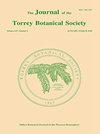Response of forest understory vegetation to a major ice storm
IF 0.8
4区 生物学
Q4 PLANT SCIENCES
引用次数: 23
Abstract
DARWIN, A.T., D. LADD, R. GALDINS, T. A. CONTRERAS AND L. FAHRIG (Dept. of Biol., Carleton University, Ottawa, ON, Canada KiS 5B6). Response of forest understory vegetation to a major ice storm. J. Torrey Bot. Soc. 131:45-52. 2004.-In January of 1998, Ottawa, Ontario was hit with a major ice storm. Detailed pre-storm vegetation data had been collected in 1997 in 164 forest interior sampling plots across a 3,000 km2 region. These data included information on shrubs/saplings, woody seeds and seedlings, herbaceous seeds and ground cover, and canopy cover. For the four growing seasons following the ice storm (1998-2001), we resampled the same 164 plots. In addition, in 1998 we estimated an ice storm damage index for each plot, and the volume of downed coarse woody debris due to the ice storm in each plot. The objectives of this paper were to examine changes in shrubs/saplings and ground vegetation in response to ice storm damage over the four-year period following the storm. Contrary to our initial expectations, we found that woody seedlings showed a large decrease in density immediately following the storm (1998). Woody seedling density recovered to pre-storm levels by 2001. We hypothesize that the decrease in woody seedling density resulted from reduced seedling germination due to lower light availability on the forest floor, which resulted from the large amount of woody debris created by the storm. We also found that shrub/sapling counts showed a large increase in 1999, most likely due to increased light to the understory, due to opening of the upper canopy. Herbaceous cover increased from 1998 to 2000, but returned to pre-storm levels the following year (2001). The between-plot variation in these understory changes was positively correlated to plot damage from the ice storm, indicating that they resulted from the storm. Overall, it appears that the forest understory plant structure is rapidly returning to pre-ice storm conditions.林下植被对一次大型冰暴的响应
达尔文、拉德、高尔庭、孔特雷拉斯、法瑞格(生物学系)。1 .卡尔顿大学,渥太华,ON, Canada [5B6]。林下植被对一次大型冰暴的响应。托里·博特。131:45-52 Soc。2004.1998年1月,安大略省渥太华遭遇了一场严重的冰暴。1997年在3000平方公里范围内的164个森林内部样地收集了详细的风暴前植被数据。这些数据包括灌木/树苗、木本种子和幼苗、草本种子和地被物以及树冠覆盖物的信息。在冰暴之后的四个生长季节(1998-2001),我们对164个样地进行了重新采样。此外,我们在1998年估算了每个样地的冰暴破坏指数,以及每个样地由于冰暴而掉落的粗木屑的体积。本文的目的是研究在冰暴之后的四年时间里,灌木/树苗和地面植被对冰暴破坏的响应变化。与我们最初的预期相反,我们发现木本幼苗的密度在风暴过后立即大幅下降(1998年)。木本幼苗密度在2001年恢复到风暴前的水平。我们假设木本幼苗密度的下降是由于风暴造成的大量木本碎片造成森林地面光照不足,导致幼苗发芽减少。我们还发现1999年灌木/树苗的数量有很大的增加,这很可能是由于上层冠层的开放增加了林下的光照。1998 - 2000年草本覆盖面积增加,但次年(2001年)又恢复到风暴前的水平。这些林下植被变化的样地间变化与冰暴造成的样地破坏呈正相关,表明它们是由冰暴造成的。总体而言,森林林下植物结构似乎正在迅速恢复到冰暴前的状态。
本文章由计算机程序翻译,如有差异,请以英文原文为准。
求助全文
约1分钟内获得全文
求助全文
来源期刊
CiteScore
0.70
自引率
0.00%
发文量
16
审稿时长
>12 weeks
期刊介绍:
The Journal of the Torrey Botanical Society (until 1997 the Bulletin of the Torrey Botanical Club), the oldest botanical journal in the Americas, has as its primary goal the dissemination of scientific knowledge about plants (including thallopyhtes and fungi). It publishes basic research in all areas of plant biology, except horticulture, with an emphasis on research done in, and about plants of, the Western Hemisphere.

 求助内容:
求助内容: 应助结果提醒方式:
应助结果提醒方式:


